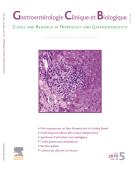Le microbiote intestinal humain - 01/10/10
Résumé |
Le microbiote intestinal humain constitue un écosystème complexe, qui est maintenant bien reconnu pour son impact sur la santé et le bien-être de l’Homme. Il contribue à la maturation du système immunitaire et assure une barrière directe contre la colonisation par des agents pathogènes. Son implication possible dans les maladies des sociétés modernes, dont la prévalence est en augmentation, a été décrite. Ces maladies sont notamment les allergies, les maladies inflammatoires de l’intestin et, peut-être, des troubles métaboliques et dégénératifs. L’analyse de la composition moléculaire du microbiote intestinal humain indique des variations interindividuelles marquées, qui pourraient sembler paradoxales étant donné le haut degré de conservation des fonctions majeures du microbiote intestinal, telles que la digestion anaérobie des fibres alimentaires. Nous avons caractérisé un noyau phylogénétique au sein du microbiote intestinal humain, en termes de composition, c’est-à-dire un ensemble d’espèces conservées qui pourraient être responsables des fonctions conservées majeures. Sur la base d’évaluations moléculaires indépendantes des cultures, les connaissances actuelles permettent de définir les critères qualifiant l’état normal du microbiote intestinal humain, ou « normobiose ». Cela permet en outre l’identification d’écarts spécifiques par rapport à la normobiose, c’estàdire d’une dysbiose, dans les maladies immunitaires, métaboliques ou dégénératives. La maladie de Crohn notamment, qui est une maladie inflammatoire de l’intestin dont l’étiologie est encore inconnue, est associée à une dysbiose intestinale avec une plus faible représentation du groupe Clostridium leptum parmi le phylum des Firmicutes. Nous avons en outre montré que l’espèce bactérienne Faecalibacterium prausnitzii possède des propriétés anti-inflammatoires in vitro et dans des modèles animaux ; cela pourrait expliquer sa capacité, lorsqu’elle est détectée dans le microbiote associé à la muqueuse de patients in vivo, à protéger ces patients contre une récidive postopératoire des signes endoscopiques d’inflammation 6 mois après la résection chirurgicale de la région iléocæcale de l’intestin. En confirmant le rôle majeur joué par le microbiote dans les troubles en relation avec l’intestin, qui sont en particulier associés à une rupture de l’homéostasie, nous procédons actuellement à des analyses métagénomiques fonctionnelles à haut débit dans le but d’identifier les molécules signal et les mécanismes d’interaction bactériehôte. Conjointement avec la description de haute résolution du métagénome intestinal humain, ainsi qu’avec des explorations des protéines et métabolites environnementaux, ces observations nous permettront de mieux comprendre les rôles fonctionnels joués par les bactéries dans l’entretien de la santé et du bien-être chez l’Homme. De nouvelles perspectives s’ouvriront alors pour la surveillance et la mise au point de stratégies de modulation du microbiote pour l’optimisation de la santé.
Il testo completo di questo articolo è disponibile in PDF.Summary |
The human intestinal microbiota constitutes a complex ecosystem which is now well recognized for its impact on human health and well-being. It contributes to maturation of the immune system and provides a direct barrier against colonization by pathogens. Its possible implication in diseases of modern societies, currently increasing in prevalence, has been reported. These include allergies, inflammatory bowel diseases and possibly metabolic and degenerative disorders. The analysis of the molecular composition of the human intestinal microbiota indicates marked inter-individual variations which may seem paradoxical considering the high degree of conservation of major functions of the intestinal microbiota such as anaerobic digestion of alimentary fibres. We have characterized a phylogenetic core within the human intestinal microbiota, in terms of composition, i.e., a set of conserved species that could be responsible for major conserved functions. Based on culture-independent molecular assessments, current knowledge enables a definition of criteria qualifying the normal state of the human intestinal microbiota that we call normobiosis. This further enables the identification of specific deviations from normobiosis, i.e., dysbiosis in immune, metabolic or degenerative diseases. Notably, Crohn’s disease, an inflammatory bowel disease of yet unknown aetiology, is associated with intestinal dysbiosis with a lower representation of the Clostridium leptum group among the Firmicutes phylum. We further showed that the bacterial species Faecalibacterium prausnitzii exerts anti-inflammatory properties in vitro and in animal models; this could explain its ability, when detected in the mucosa-associated microbiota of patients in vivo, to protect patients from post-operative recurrence of endoscopic signs of inflammation 6 months after surgical resection of the ileocecal region of the gut. By confirming the major role of the microbiota in bowel-related disorders, which are especially associated with a disruption of homeostasis, we are currently applying high throughput functional metagenomic screens in order to identify signal molecules and mechanisms of bacteria-host cross-talk. Together with the high resolution description of the human intestinal metagenome, as well as explorations of environmental proteins and metabolites, these observations will further our understanding of the functional roles bacteria play in the maintenance of health and well-being in humans. It will open new perspectives for the monitoring and design of strategies for modulating the microbiota for health.
Il testo completo di questo articolo è disponibile in PDF.Mappa
| La version originale anglaise de cet article a été publiée dans le Suppl. 1. Pour citer cet article : Doré J, Corthier G. The humann intestinal humain. Gastroenterol Clin Biol 2010;34:S7–S15. |
Vol 34 - N° 4S1
P. 7-16 - Settembre 2010 Ritorno al numeroBenvenuto su EM|consulte, il riferimento dei professionisti della salute.


